Introducing Malaysia’s Traditional Dishes
If you’re heading to Malaysia and want to experience its vibrant food culture without spending hours on research, you’re in the right place. This article is a practical guide to the best food in Malaysia, with concise descriptions to help you know what to try, where to find it, and what to expect.
We’ve also included a downloadable PDF checklist at the end—perfect for food-loving travelers who want to track what they’ve tasted and jot down personal notes.
Looking for a deep dive into the history, techniques, and cultural roots of Malaysian cuisine? Check out our full guide to Malaysian cuisine on the website.
Table of Contents
Best Food to Try in Malaysia: Main Dishes
1. Nasi Lemak (Coconut Milk Rice)
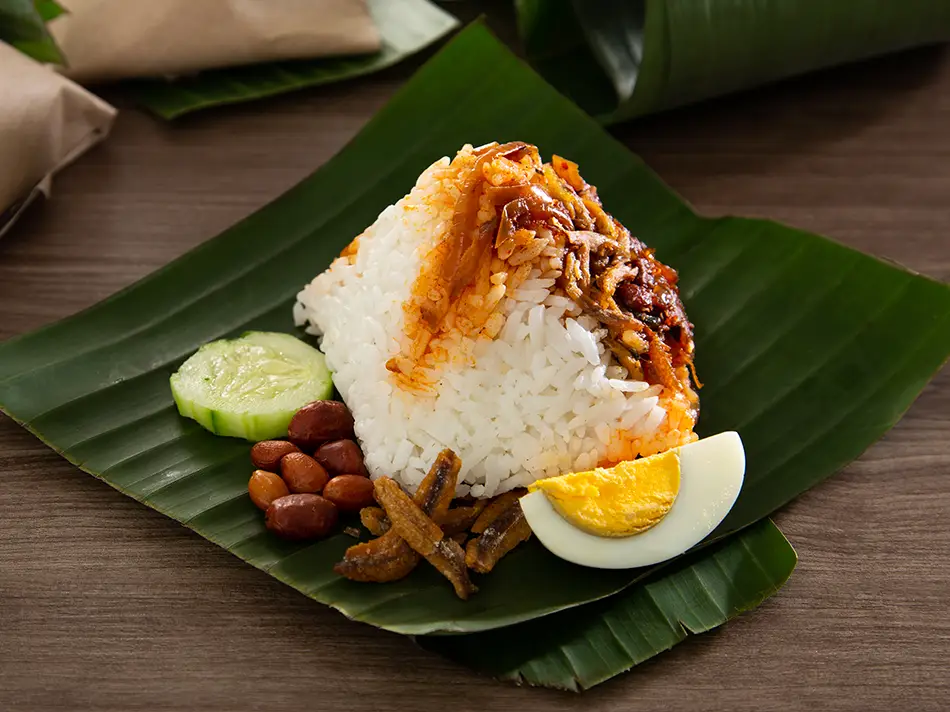
This is a foundational Malaysian dish centered around rice cooked in coconut milk and pandan leaf, a fragrant tropical plant. It is typically served on a banana leaf with a variety of accompaniments. Key among them is sambal, a spicy chili paste.
Other standard components include fried anchovies, roasted peanuts, a hard-boiled or fried egg, and slices of cucumber. You can often add side dishes like fried chicken or beef rendang.
2. Nasi Kerabu (Blue Herb Rice)
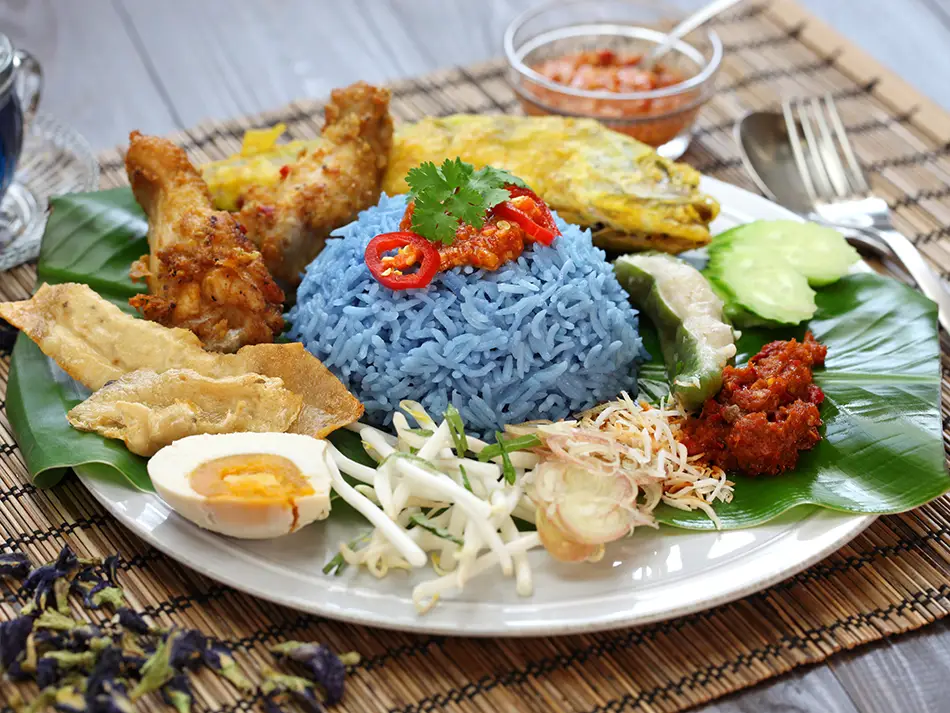
A visually distinct rice dish from the country’s east coast, Nasi Kerabu features blue-hued rice. The color comes from the petals of the butterfly-pea flower. The rice is served with an assortment of fresh, finely shredded herbs and vegetables like bean sprouts and long beans.
It is often topped with toasted coconut, fish crackers, and a choice of protein such as fried chicken, grilled beef, or salted egg.
3. Nasi Dagang (Coconut Rice With Tuna)
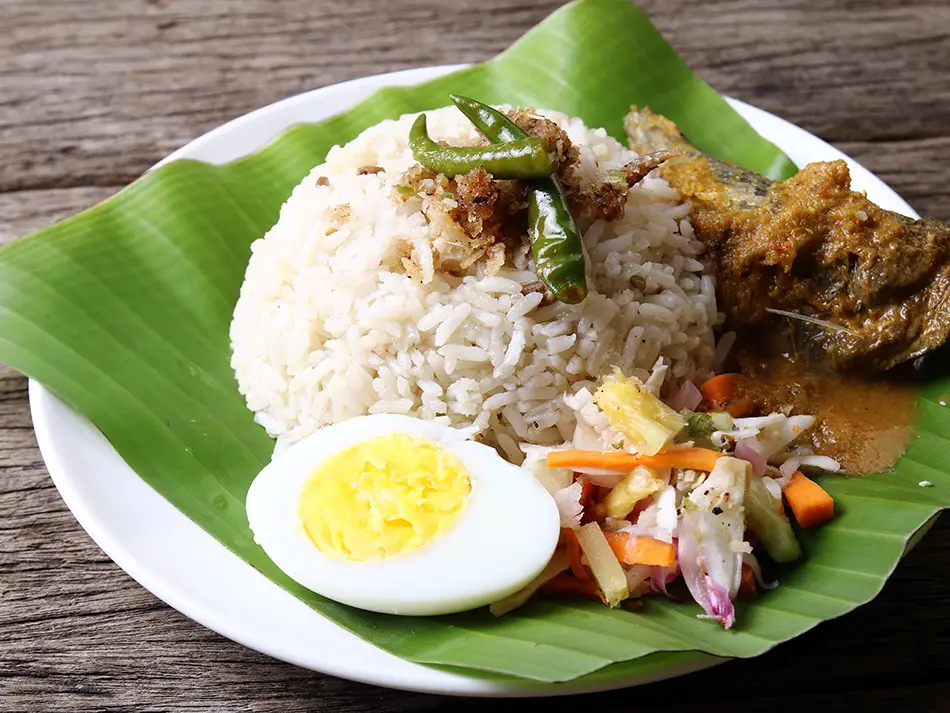
Another specialty from the east coast, Nasi Dagang consists of rice steamed with coconut milk and fenugreek seeds, which give it a unique aroma. The rice has a slightly glutinous texture. It is traditionally served with Gulai Ikan Tongkol, a specific tuna curry that is rich with spices.
The meal is completed with pickled vegetables, known as acar, which provide a balancing sour note.
4. Masak Lemak Cili Padi (Spicy Coconut Curry)
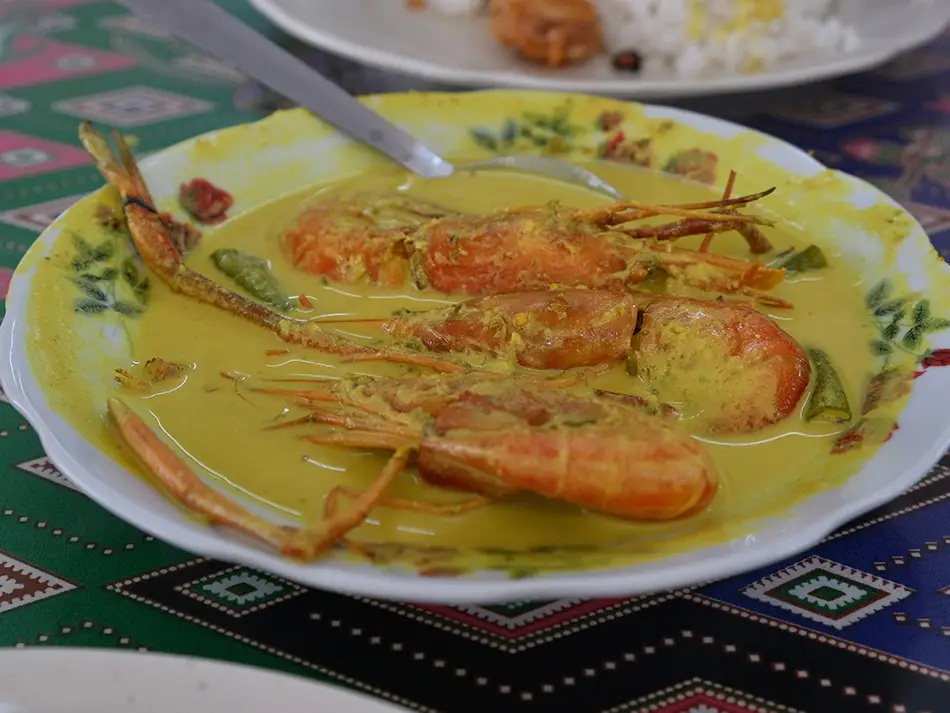
This dish features a rich, creamy gravy made from coconut milk, turmeric, and plenty of cili padi, or bird’s eye chilies, for a satisfying hit of heat. Whether made with chicken, beef, prawns, or smoked meat, it’s a bold, aromatic example of foods to try in Malaysia, blending silky coconut richness with a lively, spicy kick.
5. Ayam Percik (Grilled Coconut Chicken)
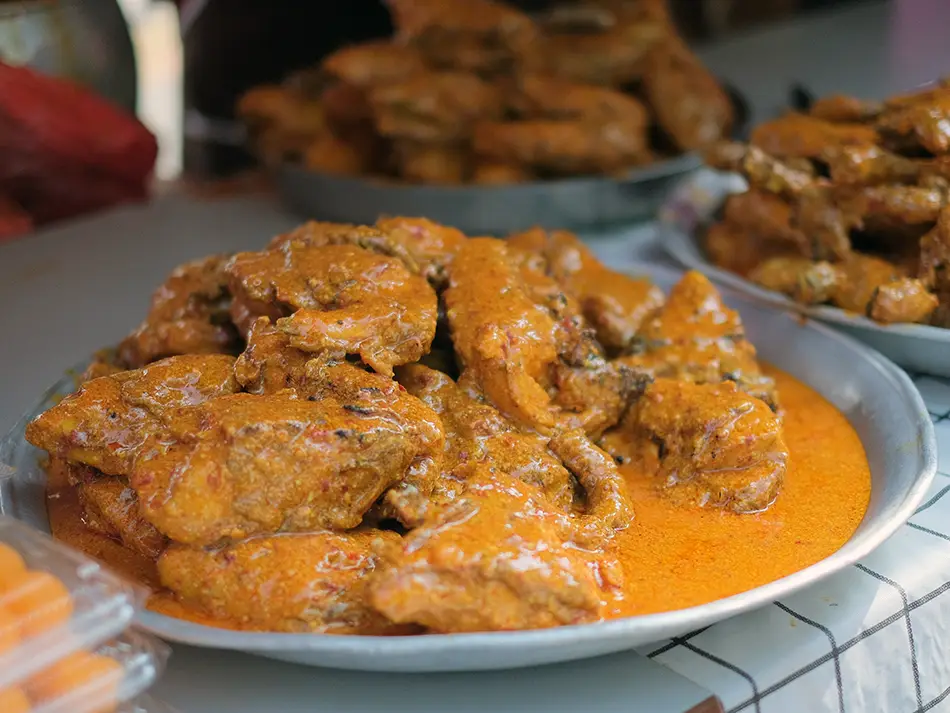
Ayam Percik is grilled or roasted chicken marinated in a blend of spices like turmeric, lemongrass, and ginger. During grilling, the chicken is repeatedly basted with a rich, spiced coconut milk gravy. This process creates a flavorful crust on the outside while keeping the meat moist.
The final dish is often served with the remaining sauce poured over the top.
6. Ikan Bakar (Grilled Banana-Leaf Fish)
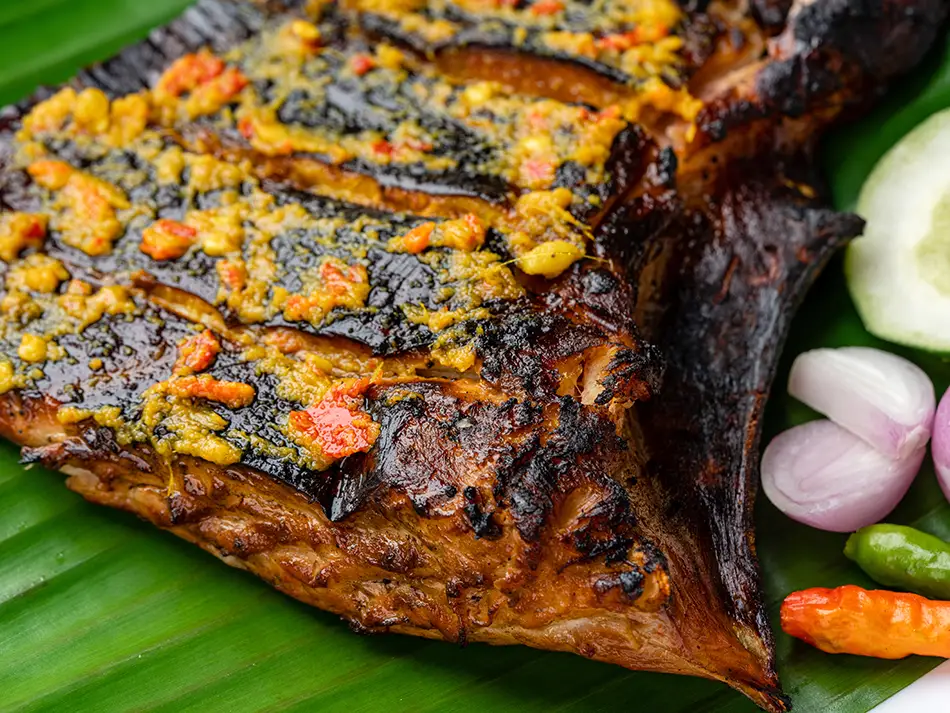
This refers to grilled fish, a popular preparation method found throughout the country. The fish, which could be mackerel, stingray, or red tilapia, is marinated in a paste of spices and chilies. It is then wrapped in a banana leaf to prevent it from drying out and grilled over charcoal.
Ikan Bakar is typically served with a tangy dipping sauce made from soy sauce, chilies, and lime.
7. Manok Pansuh (Bamboo-Cooked Chicken)
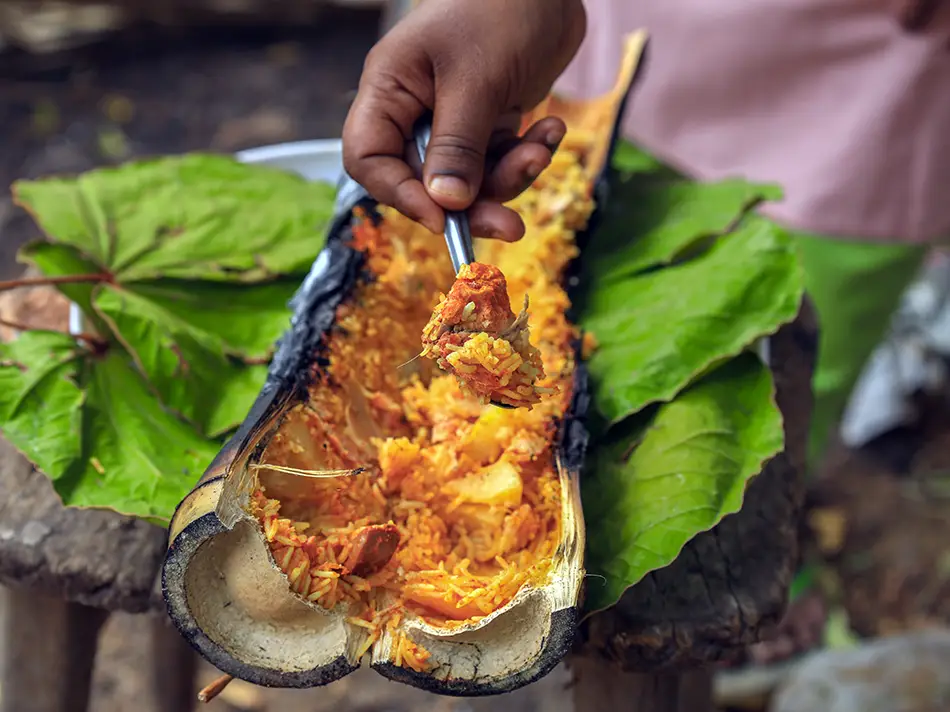
A signature dish of the Iban people in Sarawak, Manok Pansuh is chicken cooked inside a bamboo stalk over an open fire.
The chicken is seasoned with ingredients like lemongrass, ginger, and tapioca leaves. The bamboo seals in the moisture and infuses the chicken with a subtle, earthy aroma. The result is exceptionally tender and flavorful meat.
8. Char Kway Teow (Stir-Fried Flat Noodles)
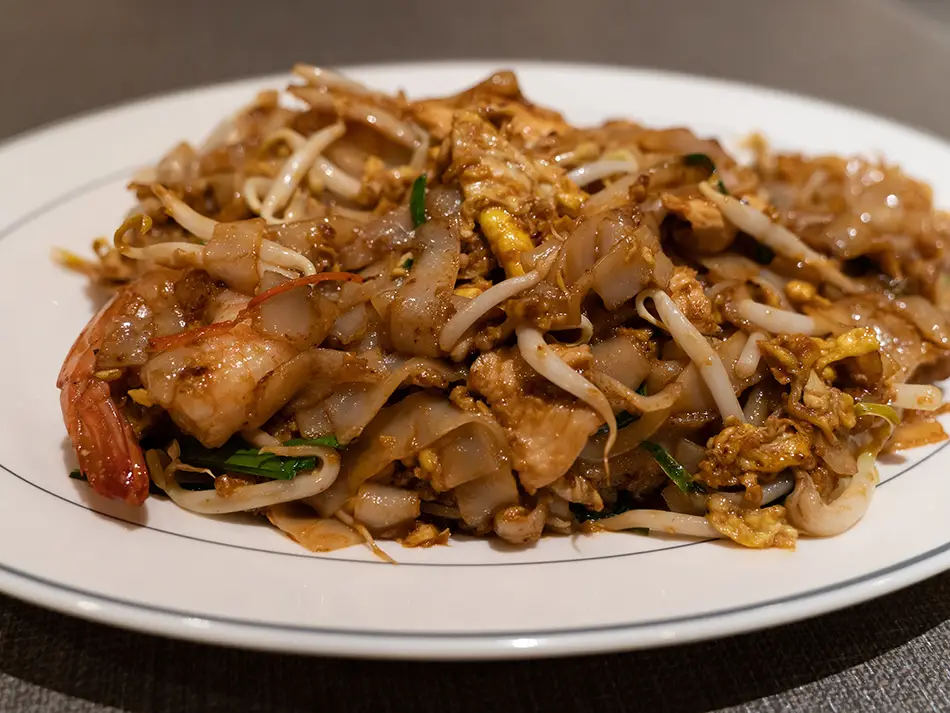
Penang-born stir-fried flat rice noodles are seared over high heat to capture the signature smoky “wok hei.” The dish typically features prawns, blood cockles, Chinese sausage, egg, bean sprouts, and chives, all tossed with light and dark soy sauce, plus optional chili or belacan.
Traditionally fried in pork lard, the Penang style is lighter with a more pronounced smokiness, while Kuala Lumpur versions are darker and a touch sweeter; halal stalls adapt it without pork or lard. It’s one of the must-try foods in Malaysia for its irresistible mix of textures, flavors, and regional variations.
Soups & Stews to Add to Your Malaysia Food List
9. Asam Pedas (Sour Spicy Fish)
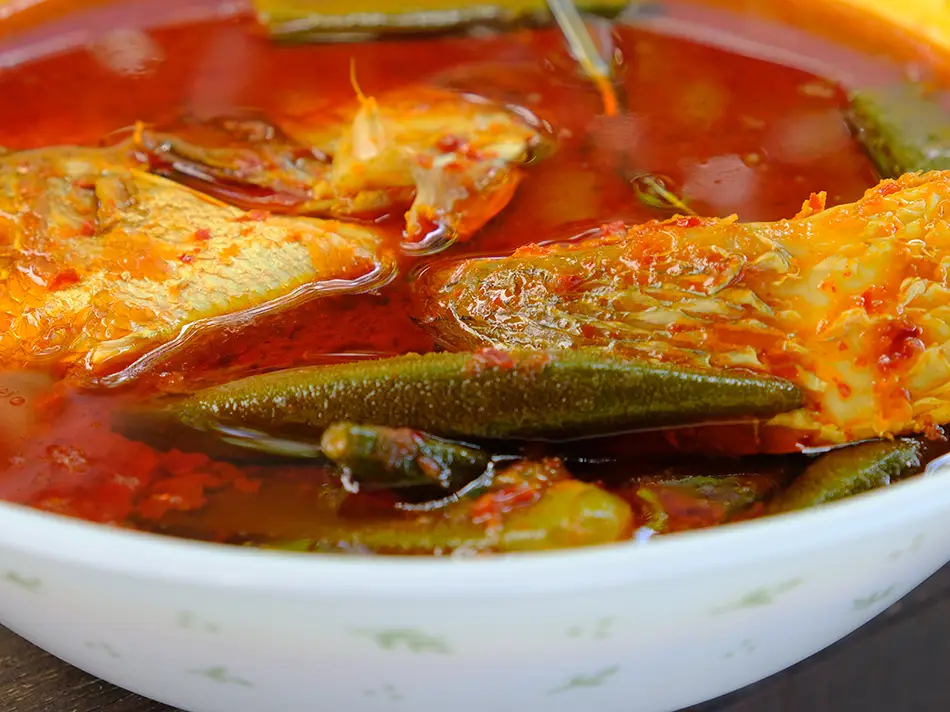
Literally translating to “sour spicy,” Asam Pedas is a fish stew known for its tangy and hot flavor. The sourness comes from tamarind (asam) juice, while the heat comes from a ground chili paste.
Other ingredients include turmeric, lemongrass, and herbs like Vietnamese coriander. It is most often made with fish like stingray or red snapper.
10. Asam Laksa (Tamarind Fish Noodles)
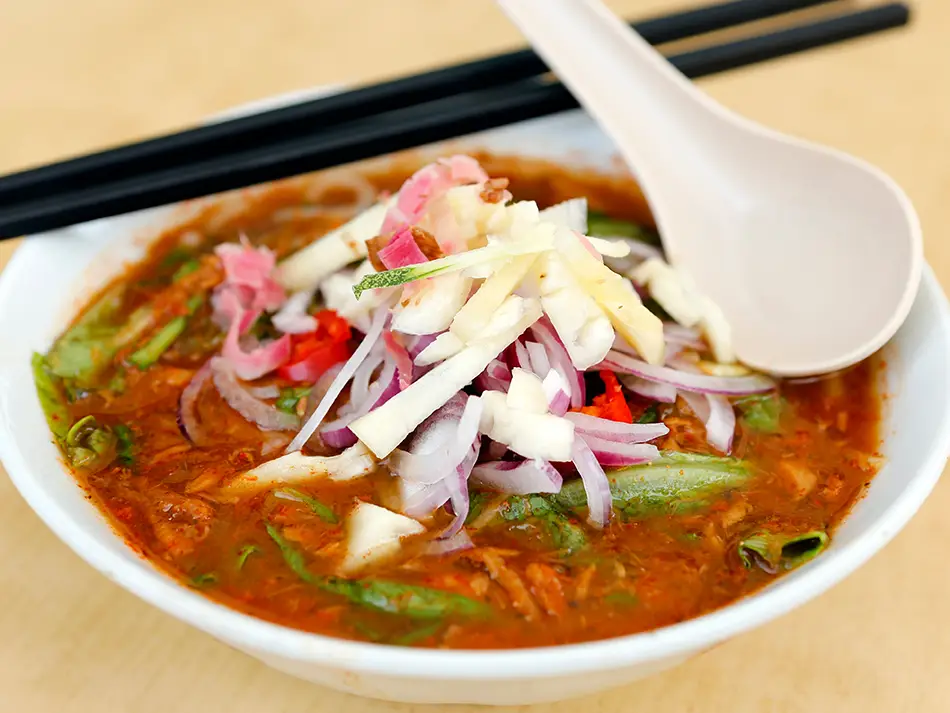
A specialty of Penang, Asam Laksa is a tangy, fish-based noodle soup that stands apart from coconut milk versions. Its fragrant broth combines mackerel, tamarind, and a rich spice paste, creating a distinctive sour-savoury depth.
Served with thick rice noodles, it’s topped with shredded lettuce, cucumber, onions, pineapple, mint leaves, and a dollop of hae ko, a sweet prawn paste. Widely celebrated for its bold, refreshing flavour, it’s among the best dishes in Malaysia for those who enjoy a balance of sourness and spice.
11. Laksa Sarawak (Spiced Coconut Noodles)
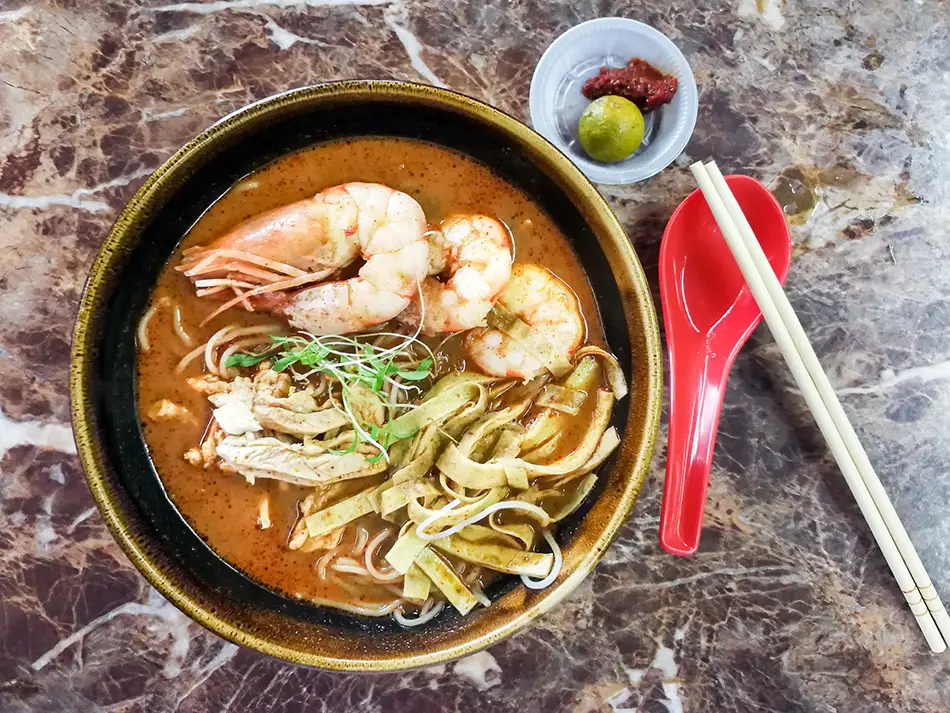
Hailing from the state of Sarawak on Borneo, this laksa has a unique broth. It is made from a base of sambal belacan (a paste of chilies and fermented shrimp) combined with coconut milk, tamarind, and other spices. The soup is served with rice vermicelli noodles and topped with shredded omelet, chicken strips, prawns, and fresh coriander.
12. Laksa Johor (Fish Coconut Spaghetti)
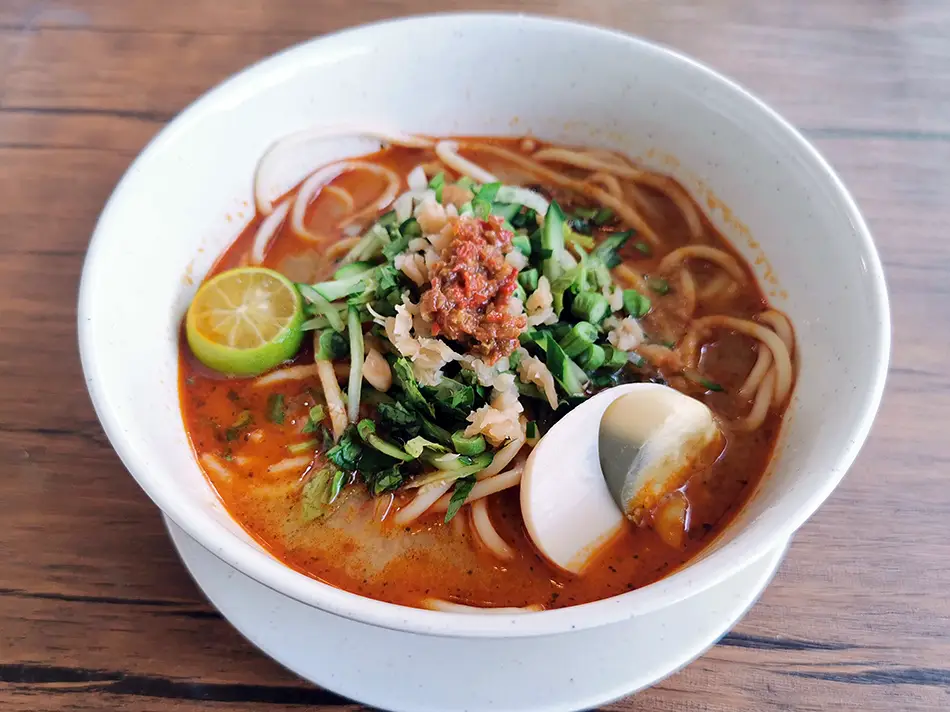
This version of laksa from the southern state of Johor is distinct because it uses spaghetti instead of traditional rice noodles. The gravy is thick and rich, made from ground fish, coconut milk, and a mix of herbs and spices. It is garnished with finely sliced cucumber, bean sprouts, onions, and herbs like basil and Vietnamese coriander.
13. Soto Ayam (Turmeric Chicken Soup)
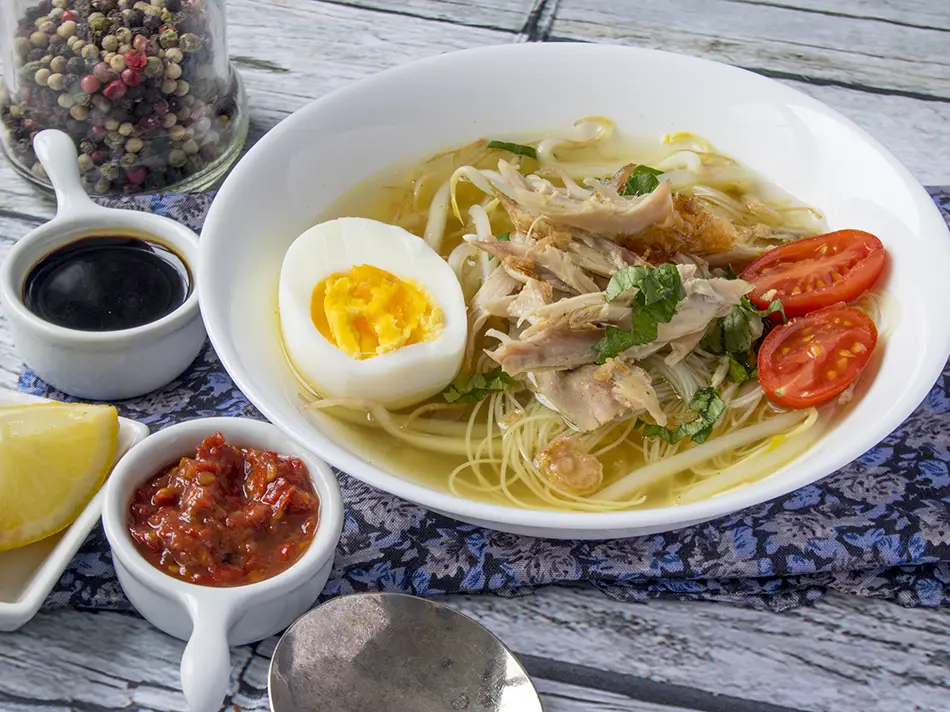
Soto Ayam is a spiced chicken soup. The broth is typically a clear, yellow color from the use of fresh turmeric. It contains shredded chicken, rice vermicelli or pressed rice cakes (nasi impit), and is often garnished with bean sprouts, fried shallots, and chopped celery leaves. A dollop of sambal is usually added for heat.
14. Bak Kut Teh (Herbal Pork Rib Soup)
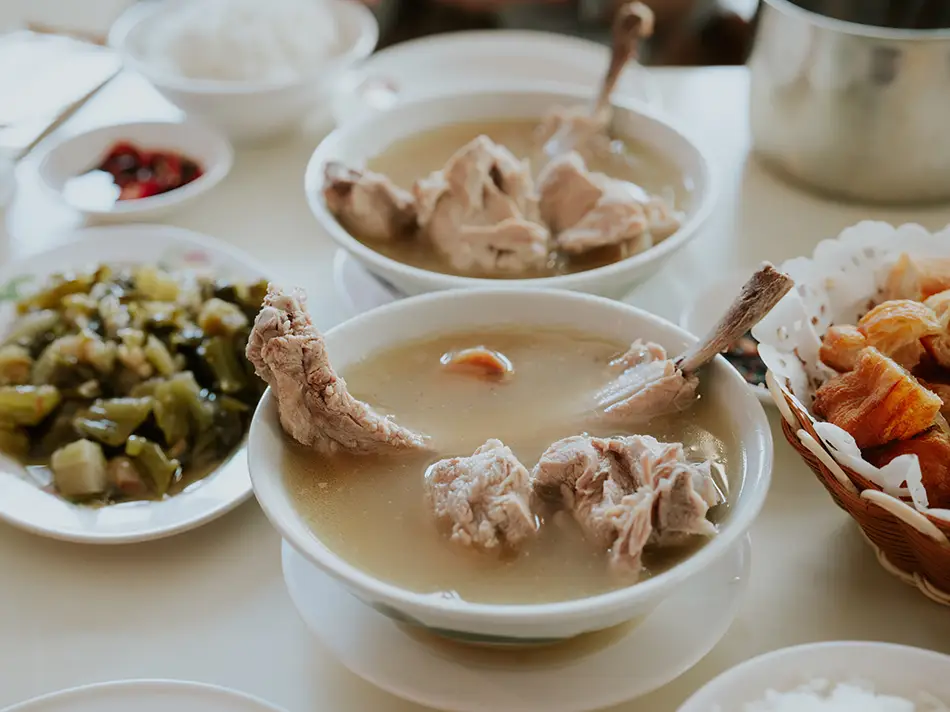
Literally meaning “meat bone tea,” Bak Kut Teh is a hearty pork rib soup simmered with a fragrant blend of herbs and spices such as star anise, cinnamon, cloves, and garlic. Despite its name, it contains no tea—the term refers to the dark, robust broth that pairs perfectly with the tender meat.
Commonly enjoyed with rice, crispy fried dough fritters, and soy sauce with chopped chilies, this comforting favourite is one of the traditional Malaysia dishes that showcases the country’s rich Chinese culinary heritage.
15. Mee Rebus (Sweet Savory Noodles)
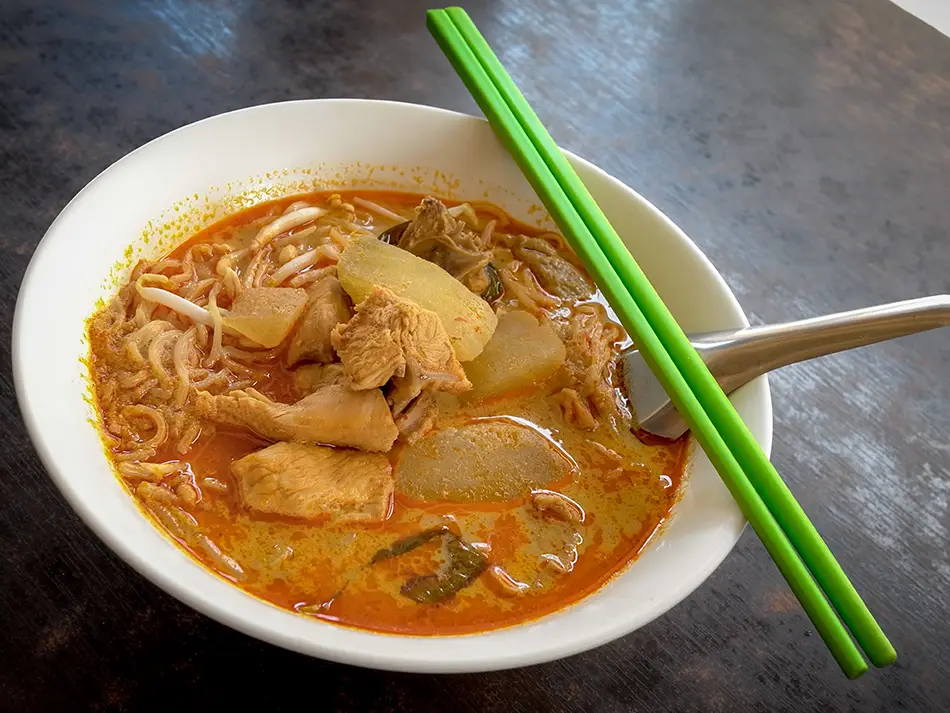
Mee Rebus, meaning “boiled noodles,” consists of yellow egg noodles in a thick, sweet and savory gravy. The gravy is made from a base of sweet potatoes, curry powder, and dried shrimp. The dish is garnished with a hard-boiled egg, fried tofu puffs, lime, spring onions, and fried shallots.
16. Sup Kambing (Spiced Mutton Soup)
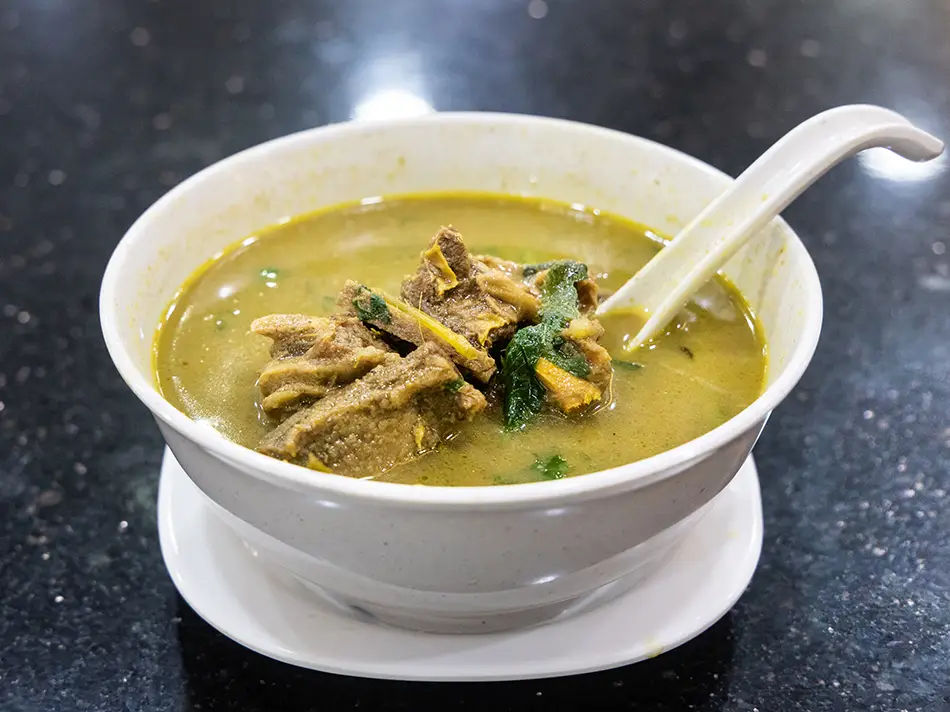
This is a hearty mutton soup simmered with a variety of aromatic spices like cardamom, cinnamon, and star anise, giving it a fragrant and warming character.
The slow-cooking process makes the mutton very tender. The soup is often garnished with fried shallots and fresh herbs and served with bread for dipping.
17. Sup Tulang (Bone Marrow Soup)
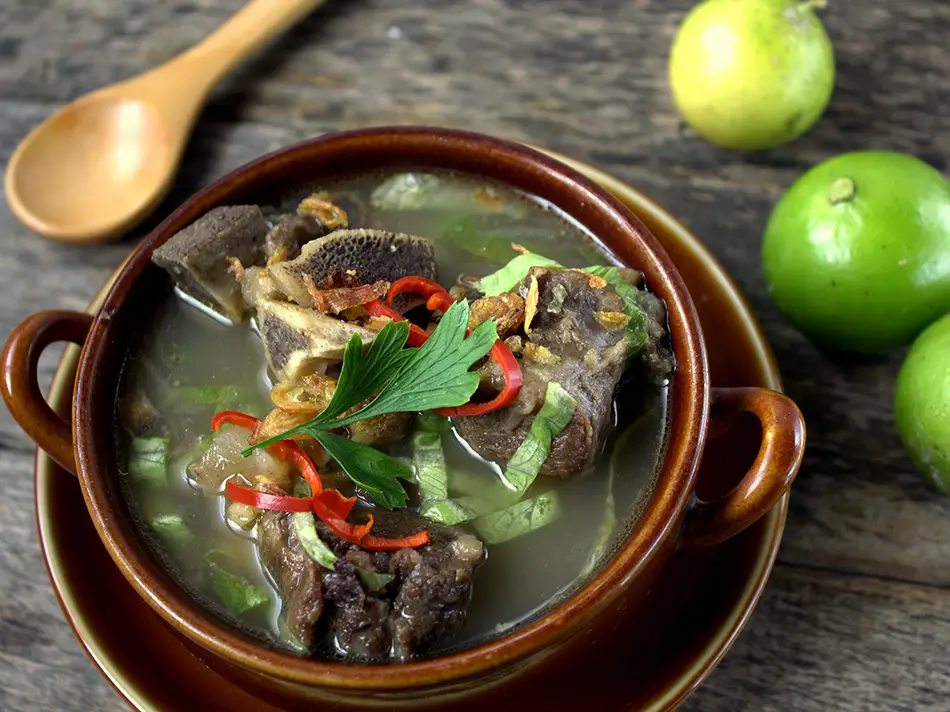
Meaning “bone soup,” Sup Tulang is a rich, flavorful broth made by simmering beef or mutton bones with meat still attached for several hours. The spices used create a savory and aromatic soup. A straw is sometimes provided to suck out the marrow from the bones. The red-colored version, “sup tulang merah,” is colored with tomato paste and chilies.
Small Plates & Cold Dishes: Must-Try Food in Malaysia
18. Satay (Grilled Meat Skewers)
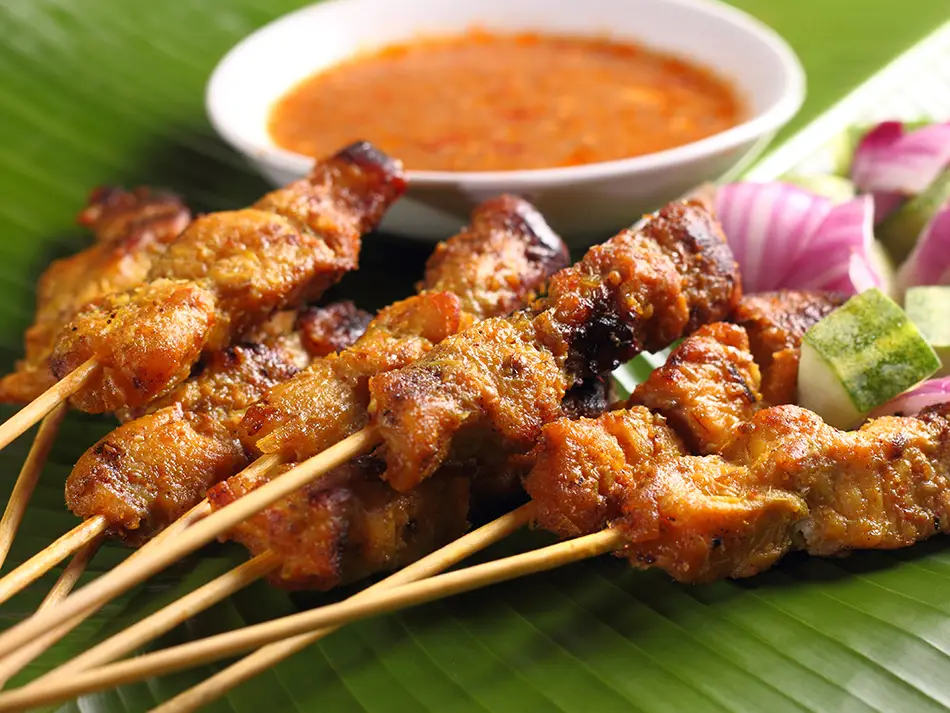
Satay is made from seasoned, skewered, and grilled meat, most often chicken, beef, or mutton. The marinade, which includes turmeric, gives the meat its signature golden hue before it’s grilled over charcoal for a smoky aroma.
Served with a rich peanut dipping sauce, fresh cucumber slices, raw onion, and ketupat (pressed rice cakes), it’s one of the famous Malaysia foods that’s equally popular at bustling night markets and festive gatherings.
19. Otak-otak (Grilled Fish Cake)
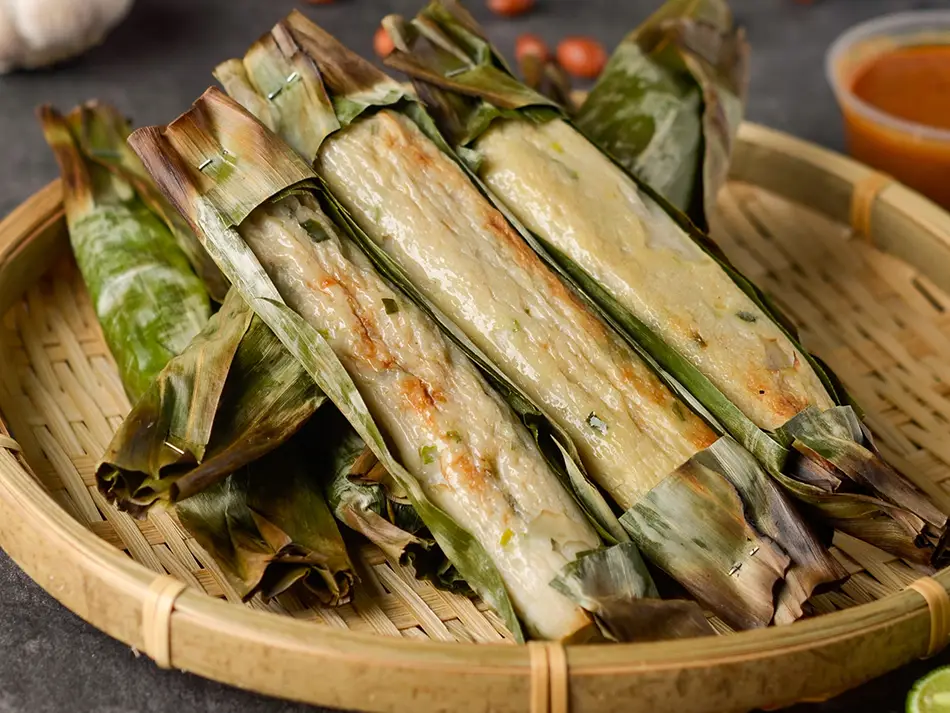
This is a grilled fish cake made from ground fish mixed with tapioca starch and spices. The mixture is wrapped in a banana or coconut leaf and then grilled over charcoal.
The name “otak-otak” means “brains” in Malay, referring to the soft, slightly mushy texture of the cooked paste. The flavor is savory and aromatic from the herbs and spices.
20. Roti Canai (Flaky Flatbread)
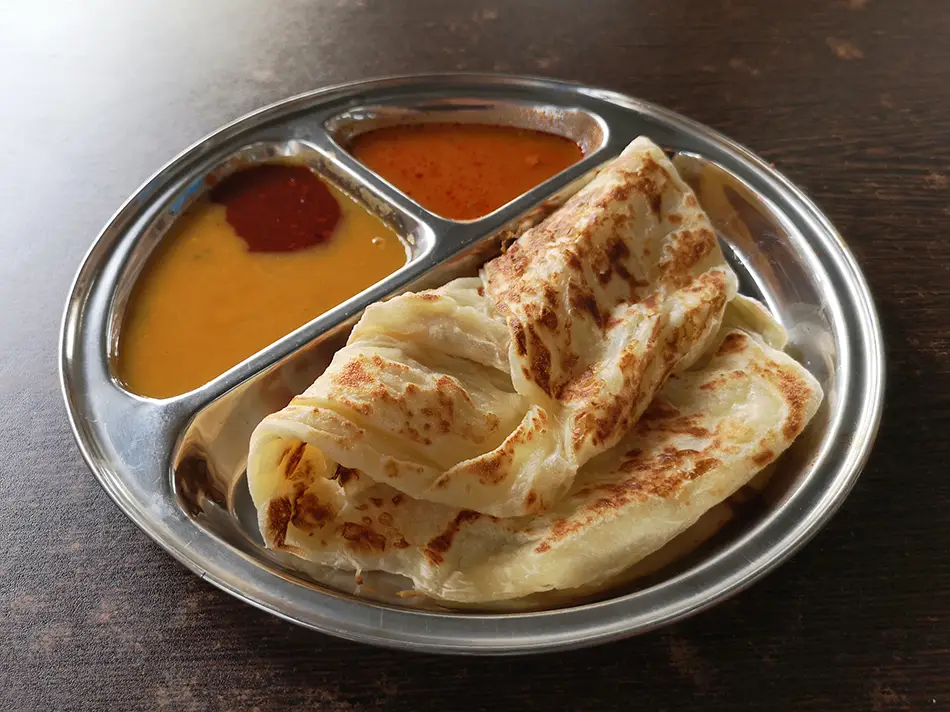
A popular flatbread of Indian origin, Roti Canai is made from a dough of flour, fat, and water. The dough is repeatedly stretched, folded, and pan-fried, creating a light, flaky texture on the inside and a crispy exterior.
It is most commonly served with a bowl of dhal (lentil curry) or other types of curry for dipping.
21. Roti Jala (Lacy Net Crepes)
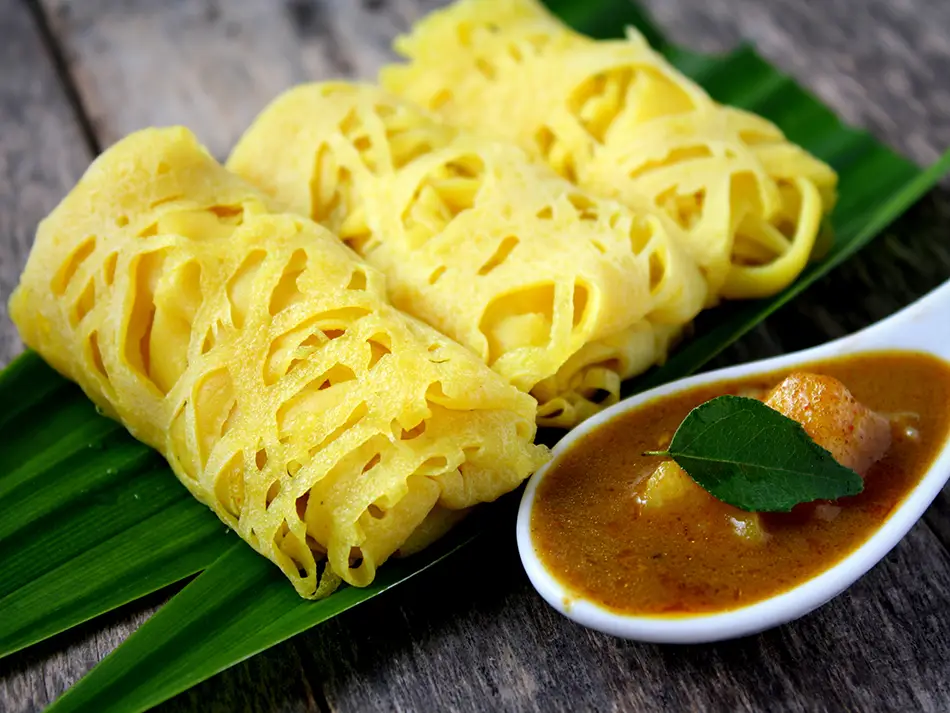
Meaning “net bread,” Roti Jala gets its name from its lace-like appearance. A liquid batter of flour, eggs, and coconut milk is drizzled onto a hot griddle in a circular motion using a special cup with multiple spouts. The resulting crepe is thin and web-like. It is typically folded and served as an accompaniment to chicken or mutton curry.
22. Keropok Lekor (Chewy Fish Snack)
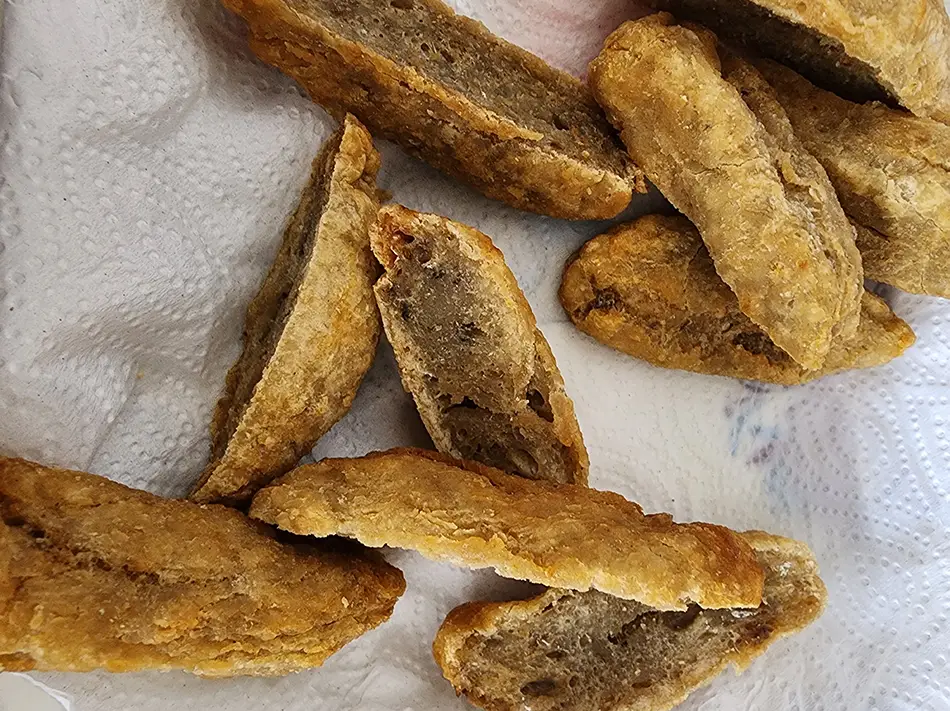
A specialty snack from the state of Terengganu, Keropok Lekor is a chewy fish sausage. It is made from a combination of ground fish and sago flour, seasoned with salt and sugar, then rolled into long shapes and boiled or fried. It is served with a sweet and spicy chili dipping sauce.
23. Popiah Basah (Fresh Spring Roll)

This is a fresh, non-fried spring roll wrapped in a soft, thin wheat-flour crepe and filled with finely grated turnip, jicama, bean sprouts, and carrots.
Variations often include fried tofu, chopped peanuts, and shredded omelet for added texture and flavor. Finished with a sweet and savory sauce before rolling, it’s a light yet satisfying example of typical Malaysia food, enjoyed as a snack or part of a larger meal.
24. Pai Tee (Crispy Pastry Cups)
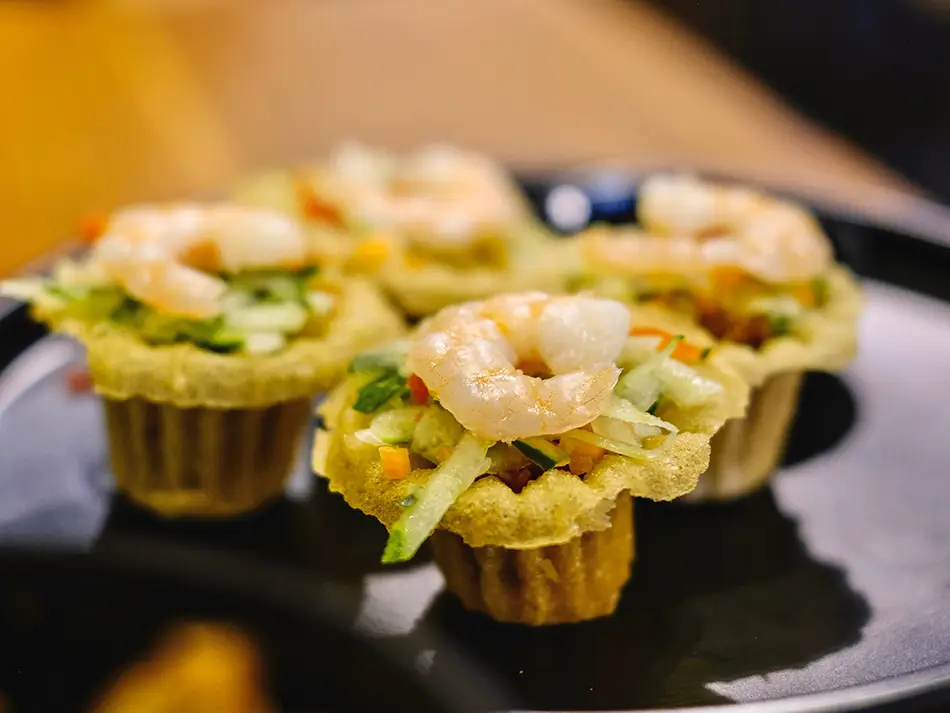
Also known as “top hats,” Pai Tee consists of crispy, cup-shaped pastry shells filled with a mixture of thinly sliced vegetables and prawns. The shells are made from a thin batter and deep-fried in a special mold. The savory filling, similar to that of popiah, is added just before serving.
25. Hinava (Lime-Cured Fish)
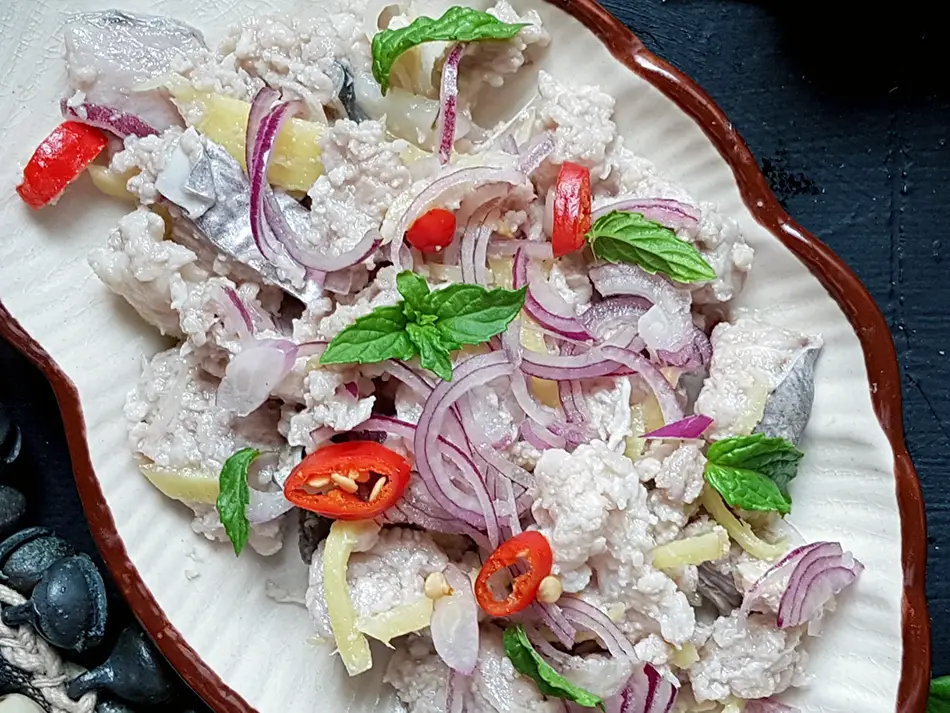
A traditional dish of the Kadazan-Dusun people of Sabah. It is made from fresh raw fish, typically mackerel, which is cured in lime juice.
The acidity of the lime “cooks” the fish. It is then mixed with sliced shallots, chili, ginger, and grated Bambangan seed, a type of wild mango.
26. Kerabu Mangga (Spicy Mango Salad)
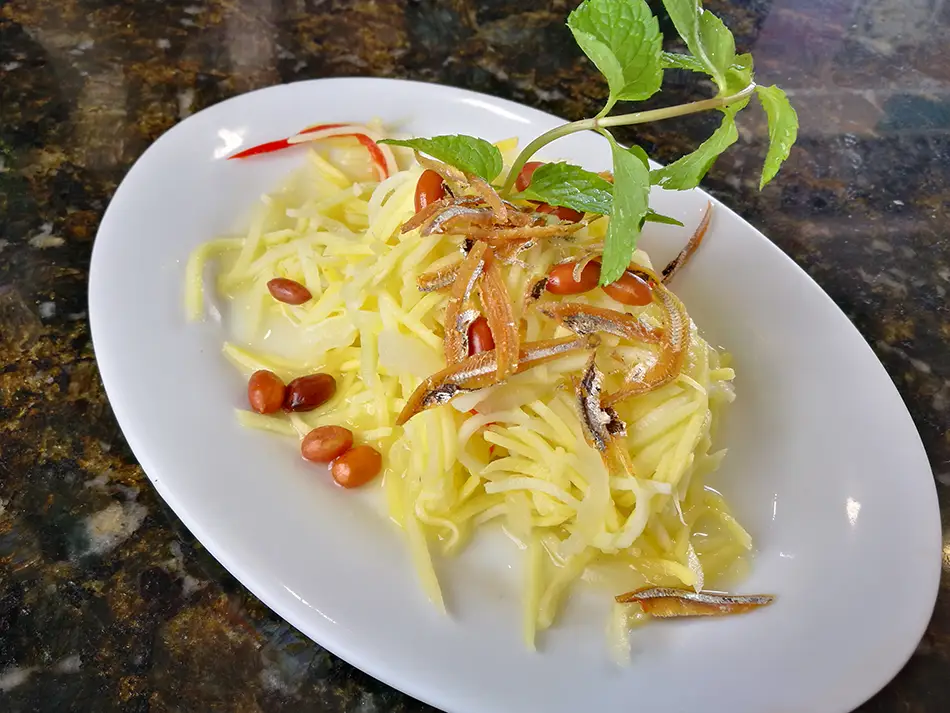
Kerabu is a type of Malaysian salad characterized by a combination of sour, spicy, and savory flavors. There are many variations. A common version is Kerabu Mangga, made with shredded unripe mango, onions, chilies, and herbs.
Another is Kerabu Bee Hoon, which uses rice vermicelli as a base mixed with a spicy coconut and fish paste.
Famous Desserts & Sweets in Malaysia
27. Cendol (Coconut Jelly Dessert)
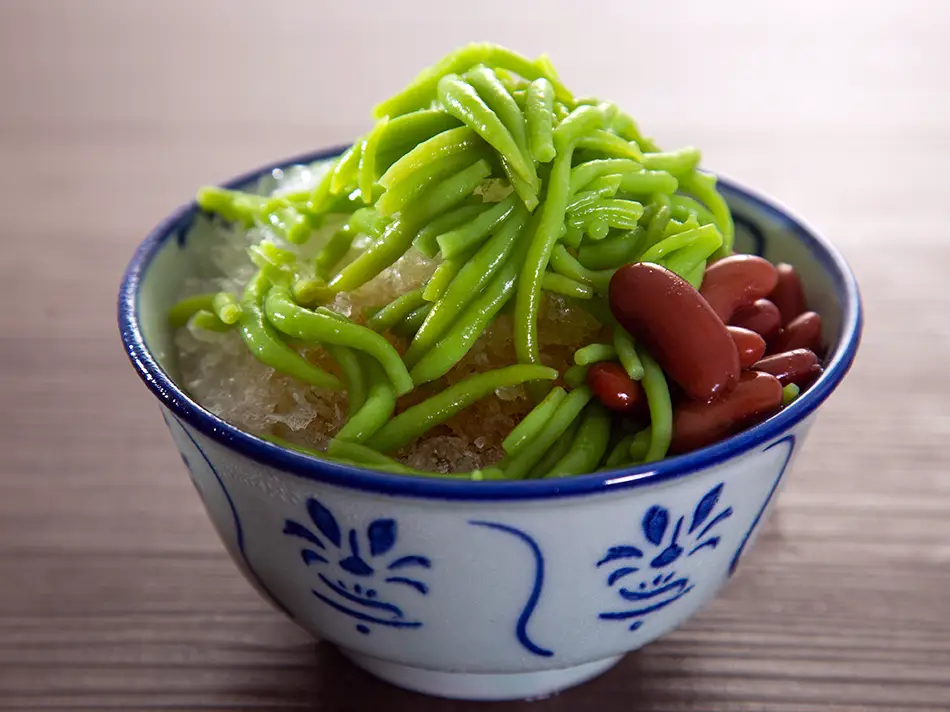
Cendol is a popular dessert consisting of three main components: shaved ice, green rice flour jelly noodles, and coconut milk. The entire dessert is sweetened with a generous drizzle of gula melaka, a dark and smoky palm sugar syrup. Some variations include toppings like sweetened red beans or creamed corn.
28. Ais Kacang (Shaved Ice Sundae)
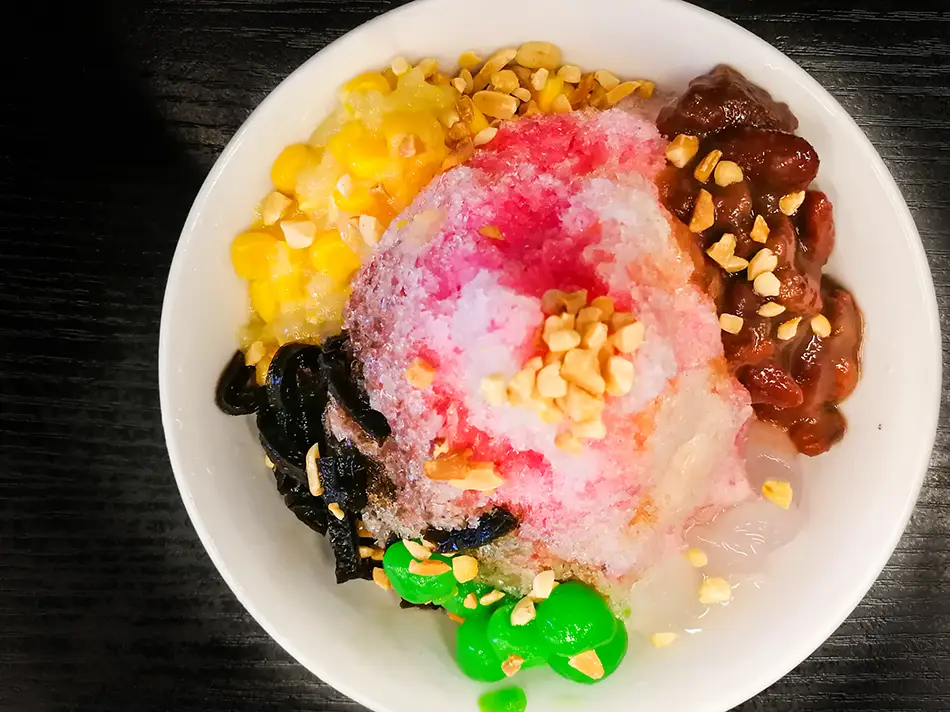
Also known as ABC (Air Batu Campur, meaning “mixed ice”), this dessert is a mound of finely shaved ice topped with a variety of colorful syrups and ingredients. Common toppings include red beans, sweet corn, grass jelly, and attap chee (palm seeds).
The entire creation is then drizzled with condensed milk or evaporated milk.
29. Bubur Cha Cha (Coconut Dessert Soup)
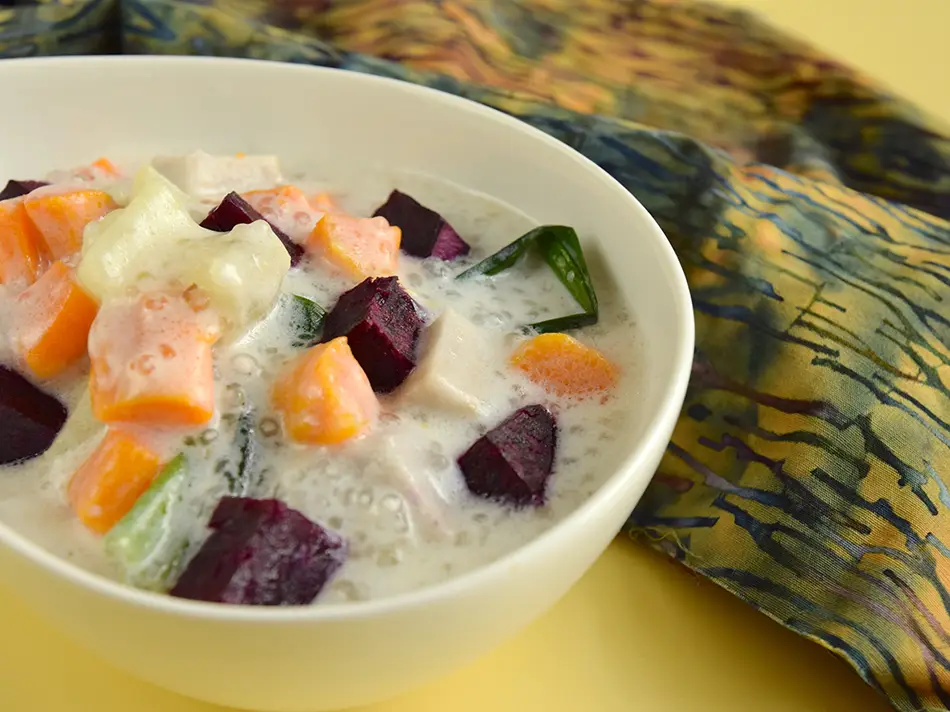
This is a sweet soup or porridge made with coconut milk. It contains a colorful mix of cooked sweet potatoes, taro, and yams, along with sago pearls and chewy, gelatinous pieces made from tapioca flour. It can be served warm or chilled and is sweetened with sugar.
30. Sago Gula Melaka (Sago With Palm Sugar)
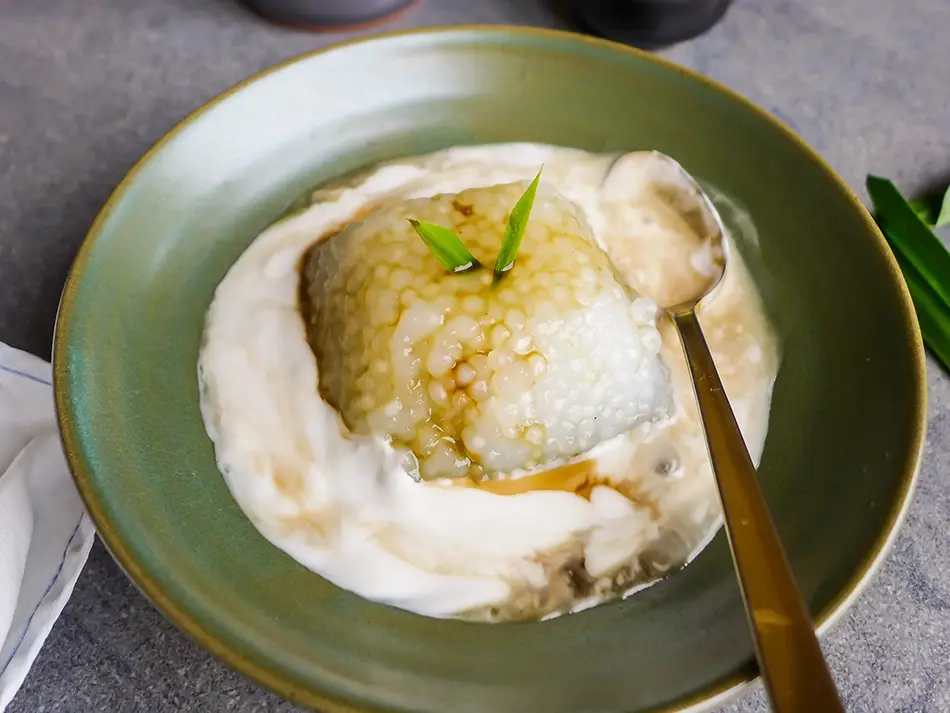
A simple but classic dessert, Sago Gula Melaka is a pudding made from sago pearls, which are small starch pearls extracted from sago palm stems.
The pearls are boiled until they become translucent and are then chilled to form a pudding. It is served with thick coconut milk and a rich gula melaka syrup.
31. Dodol (Sticky Coconut Toffee)
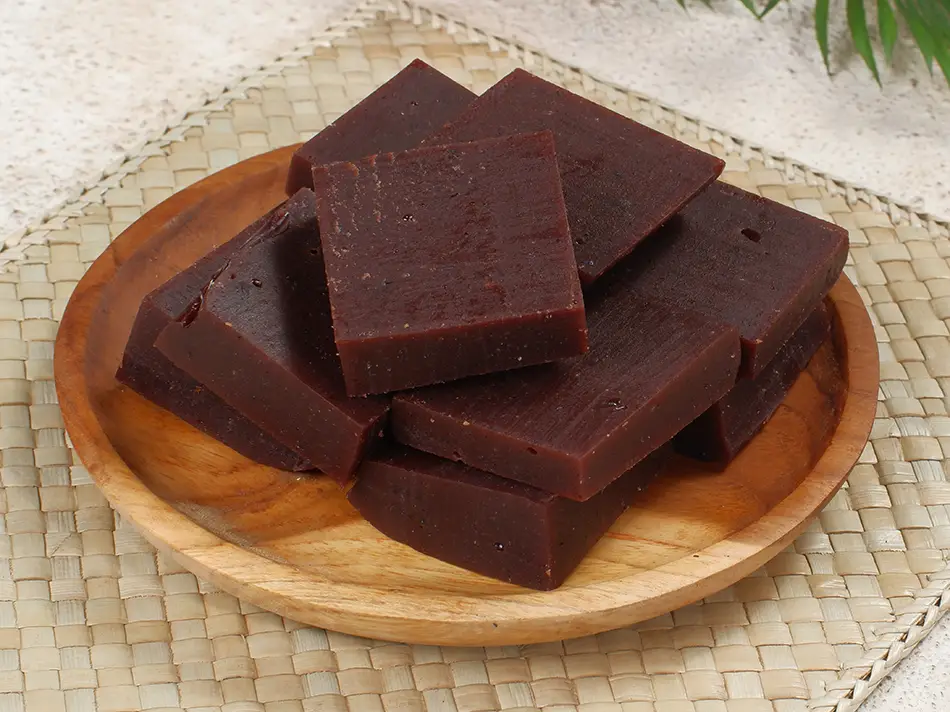
Dodol is a toffee-like, sticky sweet made from coconut milk, jaggery (a type of cane sugar), and rice flour. The mixture is continuously stirred in a large wok over heat for several hours until it becomes thick, oily, and dark.
The process is labor-intensive, but it results in a rich, chewy confection.
32. Apam Balik (Peanut Corn Pancake)

This is a griddle pancake that is folded in half. The batter is poured into a round pan, and common fillings like sugar, crushed peanuts, and creamed corn are sprinkled on top before it is folded. The texture varies from thick and fluffy to thin and crispy, depending on the vendor.
33. Putu Piring (Steamed Coconut Cakes)
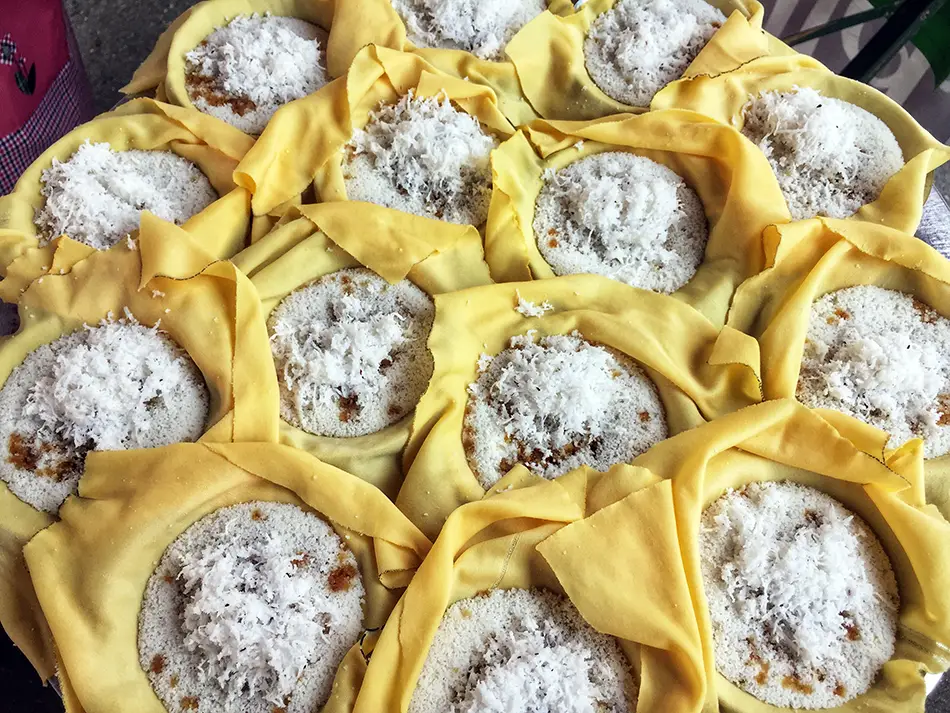
Putu Piring are steamed rice flour cakes with a sweet filling. The cakes are shaped like a small disc, made from a mixture of rice flour and water, and filled with gula melaka. They are placed on a cloth and steamed over a special steamer.
The finished cakes are served on a banana leaf with a side of freshly grated coconut.
34. Tau Fu Fa (Silken Tofu Pudding)
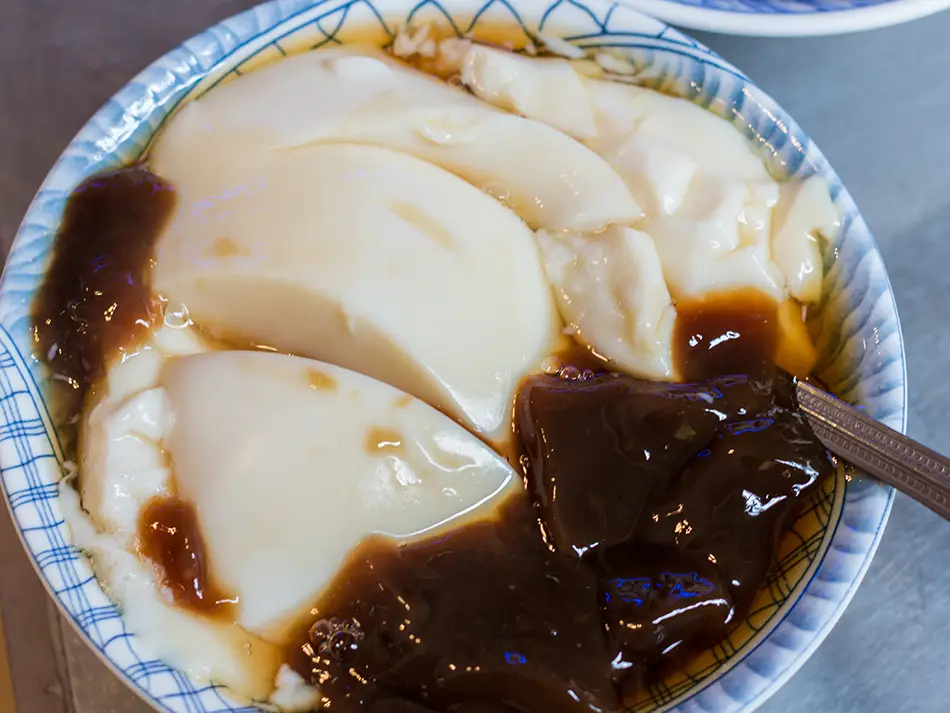
This is a soft, silken tofu pudding. The tofu has a very delicate, smooth texture. It is typically served warm, either in a clear, sweet syrup infused with ginger or in a darker syrup made from gula melaka. It is a light and comforting dessert.
35. Onde-onde (Pandan Palm-Sugar Balls)

These are small, chewy glutinous rice balls filled with liquid gula melaka. The balls are flavored and colored green with pandan juice. After being boiled, they are rolled in freshly grated coconut. When you bite into one, the melted palm sugar bursts in your mouth.
36. Seri Muka (Pandan Custard Rice)
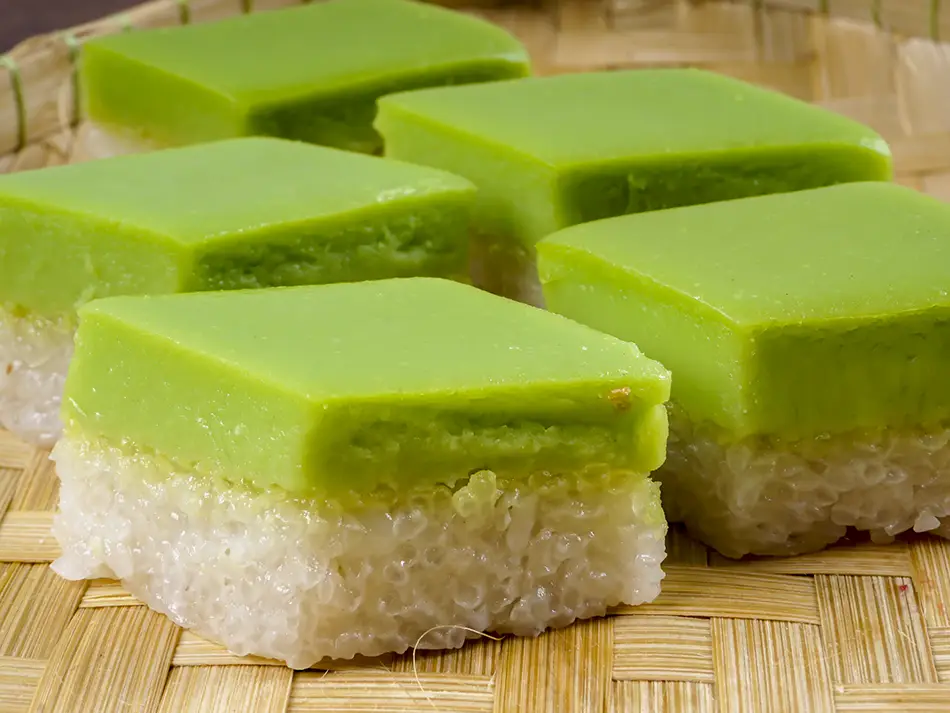
Seri Muka is a two-layered steamed cake. The bottom layer is made of glutinous rice cooked with coconut milk, giving it a savory taste and sticky texture. The top layer is a green custard made from coconut milk, eggs, sugar, and pandan juice. The combination of the salty rice and the sweet custard creates a balanced flavor.
Authentic Drinks in Malaysia
Teh Tarik
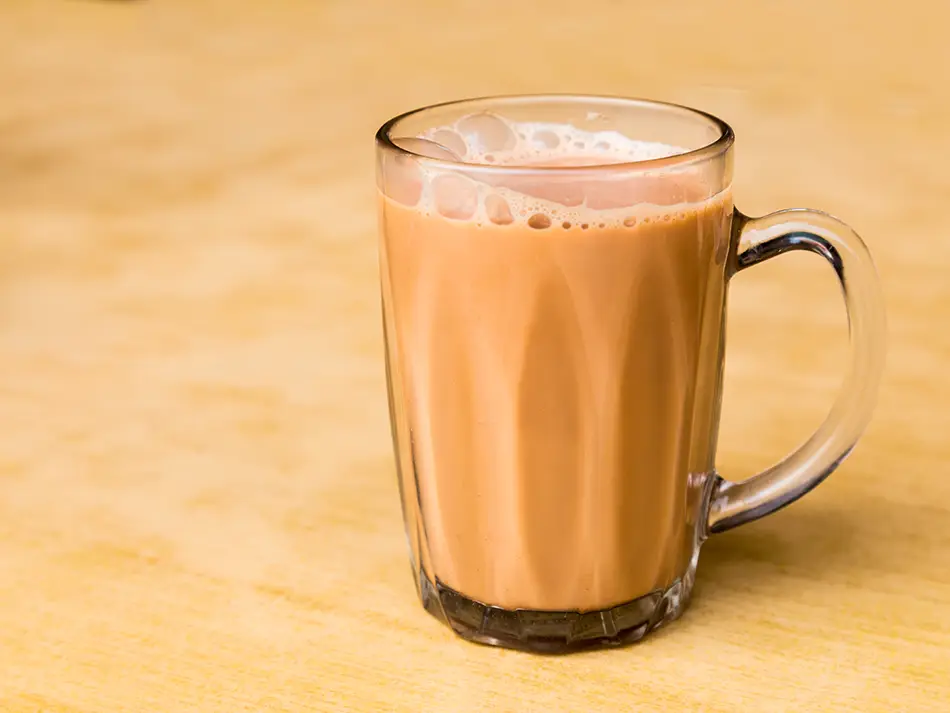
Known as “pulled tea,” Teh Tarik is the national drink. It is a strong, hot black tea mixed with condensed or evaporated milk.
The “pulling” refers to the process of pouring the tea back and forth between two vessels from a height. This cools the tea to a drinkable temperature and creates a thick, frothy top.
Sirap Bandung
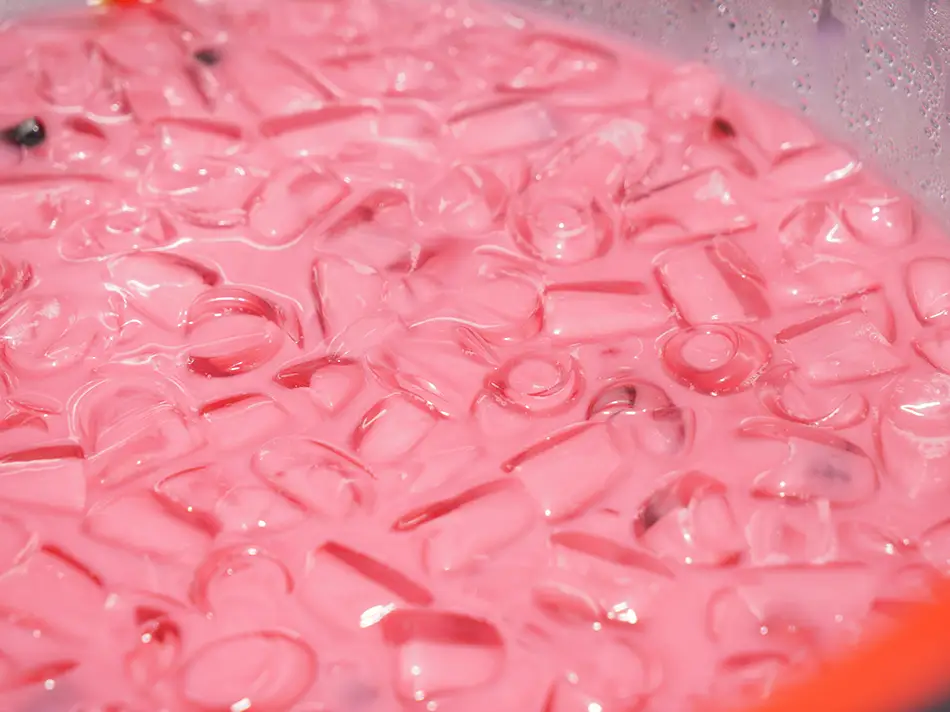
A visually striking pink drink, Sirap Bandung is made from rose syrup mixed with either condensed or evaporated milk. It is sweet, creamy, and floral. It is often served over ice, making it a common choice for breaking the fast during Ramadan or for cooling down on a hot day.
Air Mata Kucing
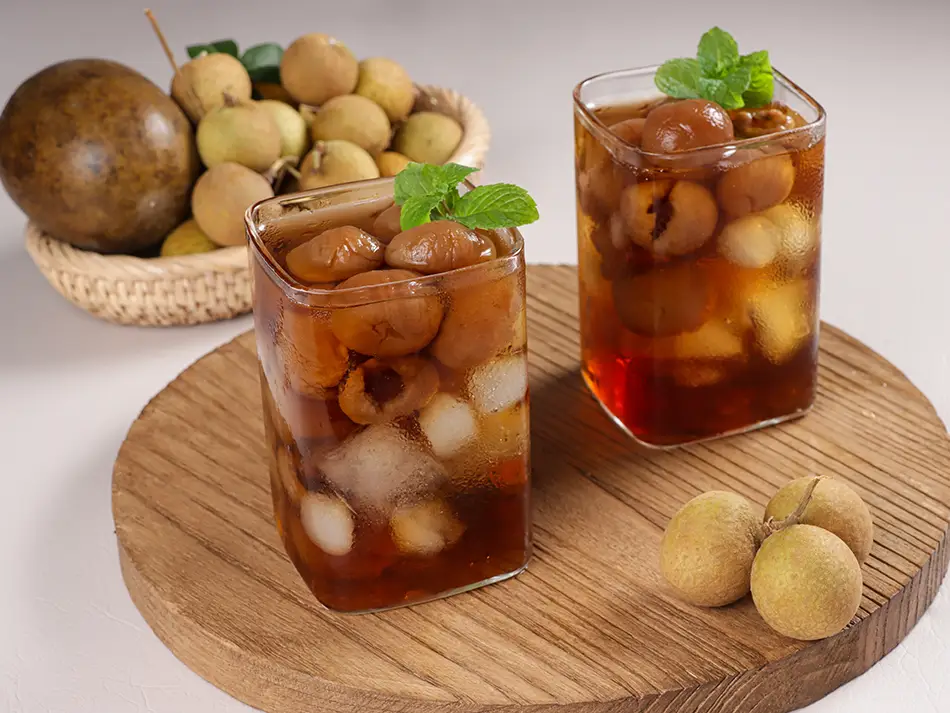
This translates to “cat’s eye water.” It is a sweet, iced herbal drink made by boiling dried longan fruit, monk fruit, and winter melon. The resulting liquid is a dark, sweet, and cooling beverage that is believed to have a cooling effect on the body.
Tuak
Tuak is a traditional rice wine, primarily associated with the Iban and other Dayak communities in Sarawak. It is made from fermented glutinous rice and yeast. The flavor can range from sweet to slightly sour, and its alcohol content varies depending on the fermentation period.
Lihing
Lihing is another type of rice wine, specific to the Kadazan-Dusun community of Sabah. Similar to Tuak, it is made by fermenting glutinous rice. It has a clear appearance and a potent, slightly sweet taste. Lihing is an important part of cultural ceremonies and celebrations in the region.
Keep Track of Your Gastronomic Journey in Malaysia
Download our fillable PDF checklist of the best food in Malaysia to stay organized on your culinary adventure. Tick off dishes as you try them, jot down notes, and create a personal record of your trip—one delicious bite at a time.
We hope this guide inspires you to explore Malaysia’s rich and diverse flavors.
Happy travels—and even happier eating!




